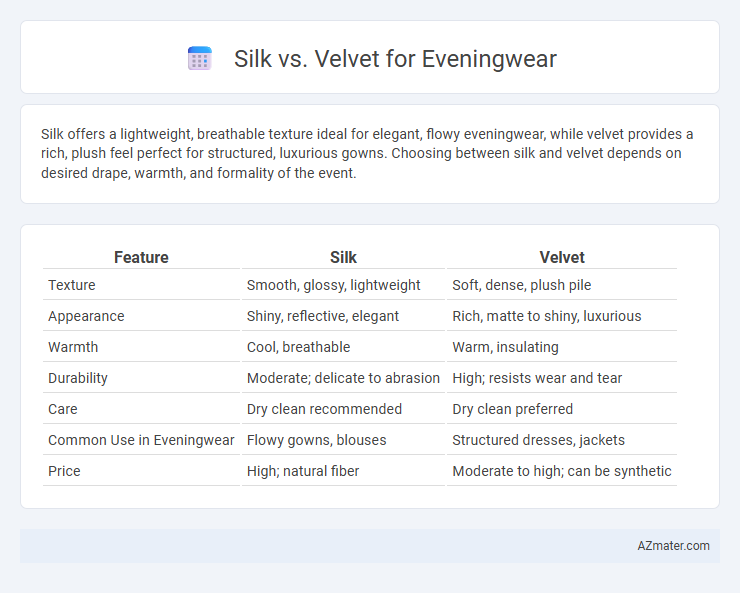Silk offers a lightweight, breathable texture ideal for elegant, flowy eveningwear, while velvet provides a rich, plush feel perfect for structured, luxurious gowns. Choosing between silk and velvet depends on desired drape, warmth, and formality of the event.
Table of Comparison
| Feature | Silk | Velvet |
|---|---|---|
| Texture | Smooth, glossy, lightweight | Soft, dense, plush pile |
| Appearance | Shiny, reflective, elegant | Rich, matte to shiny, luxurious |
| Warmth | Cool, breathable | Warm, insulating |
| Durability | Moderate; delicate to abrasion | High; resists wear and tear |
| Care | Dry clean recommended | Dry clean preferred |
| Common Use in Eveningwear | Flowy gowns, blouses | Structured dresses, jackets |
| Price | High; natural fiber | Moderate to high; can be synthetic |
Introduction: Silk vs Velvet for Eveningwear
Silk and velvet are two luxurious fabrics often chosen for eveningwear due to their rich textures and elegant appearance. Silk offers a smooth, lightweight feel with a natural sheen that enhances draping and movement, making it ideal for flowing gowns and delicate designs. Velvet provides a plush, dense texture with a subtle shimmer, lending depth and warmth perfect for structured dresses and sophisticated winter events.
Fabric Overview: Silk and Velvet Defined
Silk, a natural protein fiber produced by silkworms, is prized for its smooth texture, lightweight feel, and lustrous sheen, making it ideal for elegant eveningwear. Velvet, a woven fabric characterized by its dense pile and soft, plush surface, offers a luxurious depth and warmth suitable for sophisticated, dramatic gowns and jackets. Both fabrics provide distinct tactile and visual appeal, with silk emphasizing fluidity and shine, while velvet delivers rich texture and opulence.
Sensory Appeal: Touch and Visual Impact
Silk offers a smooth, cool touch that enhances elegance and drapes beautifully for a sleek silhouette, while its natural sheen catches light for a luminous visual impact. Velvet provides a plush, soft texture with a rich, tactile depth that adds warmth and luxury, reflecting light unevenly to create a dramatic, opulent effect. Both fabrics elevate eveningwear, but silk emphasizes fluidity and shine, whereas velvet focuses on texture and richness.
Comfort and Wearability Factors
Silk offers a lightweight, breathable texture that enhances comfort in eveningwear, adapting well to body temperature for extended wear. Velvet provides a plush, warmer feel ideal for cooler settings, adding luxurious softness but may feel heavier and less breathable. Wearability depends on event climate; silk favors warmer environments, while velvet excels in cooler, formal occasions.
Draping and Fit: How Each Fabric Falls
Silk offers a fluid drape that gracefully contours the body, creating a smooth and elegant silhouette ideal for eveningwear that emphasizes natural movement. Velvet provides a heavier, structured fall with a plush texture that adds depth and richness to the garment, enhancing formality and visual impact. The lightness of silk allows for a softer fit, while velvet's weight supports more tailored shapes and defined lines.
Color and Shine: Luster Differences
Silk eveningwear features a natural sheen that reflects light softly, enhancing vibrant colors like deep reds and emerald greens with a luminous glow. Velvet, with its dense pile, absorbs light in some areas while reflecting it off the nap, creating a rich, matte luster that intensifies darker shades such as midnight blue and burgundy. The contrast between silk's smooth, shimmering surface and velvet's plush texture influences the overall visual impact, making silk ideal for bright, radiant looks and velvet perfect for sophisticated, subdued elegance.
Versatility in Eveningwear Styles
Silk offers exceptional versatility for eveningwear with its smooth texture and natural sheen, making it ideal for sleek gowns, blouses, and scarves that complement various formal settings. Velvet's rich, plush texture brings a luxurious depth to evening outfits, especially in tailored jackets, dresses, and skirts suited for colder seasons or opulent events. Both fabrics adapt to elegant silhouettes, but silk's lightweight quality enhances fluidity while velvet's structure adds drama and warmth.
Seasonal Suitability and Climate Considerations
Silk offers exceptional breathability and moisture-wicking properties, making it ideal for warm and humid evening events, while velvet's dense pile provides superior insulation suited for cooler climates and winter occasions. The choice between silk and velvet for eveningwear hinges on the season, with silk preferred in spring and summer for its lightweight feel, and velvet favored in autumn and winter due to its warmth and luxurious texture. Climate considerations should prioritize silk's cooling effect in hot weather and velvet's ability to retain heat during cold seasons, ensuring comfort and style throughout.
Care and Maintenance Requirements
Silk eveningwear demands delicate care, requiring hand washing with mild detergent or dry cleaning to maintain its natural sheen and prevent fibers from weakening. Velvet, especially made from cotton or polyester blends, requires gentle steaming or dry cleaning to avoid crushing its pile and preserving the fabric's lush texture. Both fabrics benefit from storage in breathable garment bags to reduce moisture buildup and avoid damage from direct sunlight.
Choosing the Right Fabric for Your Event
Silk offers a luxurious sheen and lightweight drape perfect for formal eveningwear, ensuring comfort and elegance in warm settings. Velvet provides rich texture and warmth, ideal for cooler events or winter occasions, adding depth and sophistication to your outfit. Consider the event's atmosphere and climate when choosing between silk's smooth, breathable feel and velvet's plush, insulating qualities to achieve the perfect balance of style and comfort.

Infographic: Silk vs Velvet for Eveningwear
 azmater.com
azmater.com